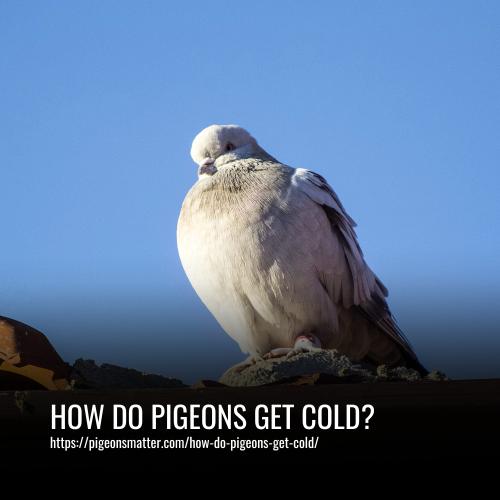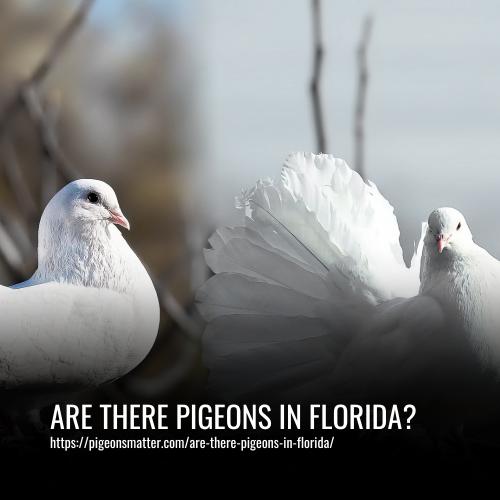Pigeons can get cold by being exposed to cold weather conditions.
Pigeons are susceptible to cold weather just like any other bird. They will huddle together to keep warm and often roost in sheltered areas. In severe weather, they may even seek out warmth from humans by sitting on a person’s head or shoulders.
Pigeons do not have feathers on their legs or feet, which makes them more vulnerable to the cold. If a pigeon gets too cold, it may stop moving and eventually die.

How Do Pigeons Survive In The Winter?
Pigeons are well adapted to surviving the cold winter conditions. To stay warm, they fluff their feathers and tuck their heads and feet under them. They also form clusters to share body heat and can adjust the flow of blood in their extremities to conserve heat.
1. Minimizing Their Exposure:
Pigeons reduce exposure by tucking their head and feet, sticking their feathers, crouching, and living in flocks to share warmth.
2. Using Feathers:
Pigeons fluff out their feathers to create pockets of air for insulation, keeping their core body temperature warm.
3. Calories:
Pigeons eat more food in winter to gain weight and build calories for insulation and energy to produce body heat.
4. Minimize Body Temperature & Metabolic Rate:
Pigeons shiver to raise their metabolic rate and reduce overall body temperature to minimize heat loss.
5. Hyperthermia & Torpor:
Pigeons bask in the sun to conserve energy, roost together to share body heat, and use hyperthermia and torpor to lower body temperature and reduce metabolic rate.
6. Eat A lot:
Pigeons eat extra food in winter to accumulate fat before nightfall to sustain them over cold nights.
7. Shiver:
When it’s really cold, pigeons may shiver all night to increase heat production and burn fat reserves to survive until warmer days arrive.
How Do Pigeons Keep Warm In Cold Weather?
Pigeons keep warm by fluffing their feathers.
Pigeons are equipped with a few key adaptations that help them withstand cold weather. Their feet are covered in feathers, which helps to insulate them from the cold ground.
They also have a layer of down feathers, which provides additional insulation. Additionally, pigeons can adjust the blood flow to their extremities, which helps to keep them warm.
One example of how pigeons keep warm in cold weather is by roosting together. Pigeons will huddle together in a group to share body heat. They will also tuck their head and feet under their feathers to further conserve heat.
How Cold Is Too Cold For Pigeons?
Pigeons, unlike animals in the Arctic region, do not have a layer of blubber to protect them from extremely cold temperatures. However, they are still able to survive in cities where it snows in winter, indicating their ability to endure cold conditions.
While pigeons cannot stand the harsh Arctic cold, they have been known to survive in temperatures as low as -40 degrees Fahrenheit. This resilience allows them to adapt and thrive in urban environments with cold winters, despite lacking the insulation of blubber.
Therefore, although pigeons do have limitations when it comes to cold temperatures, they can withstand and survive in conditions that would be too cold for many other animals.
What Happens When Pigeons Get Too Cold?
When pigeons get too cold, they have a final tactic called torpor, which is a deep sleep state. In torpor, their body uses very little energy, allowing them to survive even if their body temperature drops by as much as 50 degrees Fahrenheit.
However, in this state, pigeons become very lethargic and unable to move quickly, making them vulnerable to predators.
What Do Pigeons Do When They’re Cold?
In the winter, pigeons do not migrate. They stay close to their nests, which are imprinted on them, and can be found in urban areas in warm roof ventilators, attics, and any other warm spaces. In the wild, they seek out thick vegetation.
Pigeons show less activity during the winter to conserve body heat. They trap pockets of air in their bodies and their feathers help to keep them warm and insulated. Additionally, they huddle up together to maintain body heat.
Overall, pigeons stay close to their nests or seek out warm places, while also conserving body heat and utilizing their feathers to stay warm during the cold winter months.
Can Pigeons Freeze To Death?
Yes, pigeons can freeze to death. While they can tolerate low temperatures, getting wet and being unable to dry off can lead to them freezing. European pigeon breeds are more adapted to extreme cold thanks to the continent’s harsh winters, while those found in tropical regions may not have the same tolerance.
Do Pigeons Migrate For Surviving Cold?
No, pigeons do not migrate to survive the cold. Unlike many other bird species, pigeons stay in the same place year-round and find a warm place to live during the winter. They are very good at surviving the cold and are adaptable creatures, just like raccoons. Pigeons thrive on human food leftovers and do not run out of food in the winter, as they can find enough to eat.
They also feed on insects when they are in winter sleep. With enough food available, pigeons can survive and also feed their young by producing crop milk, so they do not need to migrate as other birds do. Overall, pigeons can withstand the cold without the need to migrate for survival.
How Do Birds Don’t Get Wet When Snow or Rain?
Birds have a preen gland called the Europa Geo Gland that secretes oil, which they use to coat their feathers when preening. This oil helps to waterproof their feathers, keeping them dry. This is important for birds, just as it is for humans, as staying dry is essential for warmth and comfort, especially in cold or wet conditions.
In addition to waterproofing their feathers, birds can also fluff up their feathers, which provides insulation against the cold. So, the combination of preen oil to waterproof their feathers and the ability to fluff up for insulation allows birds to stay dry and warm in snowy or rainy conditions.
How to tell when a pigeon is feeling cold:
Pigeons exhibit unique behaviors when they feel cold, making it easy to observe their discomfort from afar.
- Shivering: Pigeons start to shiver when they get cold, increasing their metabolism and generating more body heat to fight off the cold feeling.
- Preening: Pigeons engage in preening to coat their feathers with body oils, making them waterproof and better insulated against the cold.
- Sunning: If you see pigeons ‘sunbathing’, it’s because they feel cold and are trying to use direct sunlight to warm their bodies up.
- Tucking: Pigeons tuck their bodies, legs, or bills into their feathers when they’re cold to prevent the loss of body heat.
- Huddling: Pigeons huddle together to share body heat, effectively combating the cold.
By observing these behaviors, it is possible to tell when a pigeon is feeling cold without the need for a close examination.
How to Help Pigeons Beat Cold?
One way to help pigeons beat cold weather is to shelter them. Pigeons are very social birds, so providing them with nesting boxes can give them a warm and safe place to sleep at night.
- Providing Nutritional Food: Place a bird feeder and fill it with nutritional food suitable for pigeons and other birds, such as seeds, corn, grains, nuts, fruits, or a mix of these.
- Offering Water Source: Place a birdbath with warm water near the bird feeder or in the yard, and change the water with warm water four to five times a day during winter.
- Providing Heat Source: If keeping pigeons, provide a heat source near their cage, such as a heater, heat lamp, or heat pad. Cover their home with warm materials, especially at night when temperatures drop.
Migration seems like a solution, but the cost is high. By providing a bird feeder with black oil sunflower seeds, you can help pigeons and other birds endure the harsh weather during winter.
Where Do Pigeons Go When It’s Cold?
Pigeons in cold climates, both in the wild and in cities, prefer to stay warm in their nests during winter. In the wild, they insulate their nests with leaves and mud to endure the cold. In urban areas, they seek out warmer places like attics and roof ventilators to build their nests. They also insulate their nests with available material to stay warm.
Due to their preference to stay in their nests during winter, pigeons may appear to disappear during this season. Overall, pigeons do not migrate to warmer areas and instead rely on insulating their nests to survive in very cold climates.
How Do Pigeons Stay Healthy In Cold Weather?
Pigeons stay healthy in cold weather by staying dry and out of the wind.
When the weather outside is cold, you might see birds huddled together to stay warm. Pigeons are no different and will often flock together in cold weather. While this helps to keep them warm, it’s not the only way they stay healthy in cold weather. Here are some other ways pigeons stay warm and healthy in cold weather.
Pigeons have a special adaptation that helps them to stay warm in cold weather. Their feathers are designed to trap heat close to their body. This keeps them warm and helps to prevent heat loss.
Pigeons also have a layer of fat under their skin that helps to insulate them from the cold. This layer of fat helps to keep them warm and provides energy for them to stay active in cold weather.
Pigeons also use their beak and feet to help regulate their body temperature. Their beak is full of blood vessels that help to warm the blood. Their feet are also full of blood vessels and they will often perch on one leg to keep the other leg warm.
Pigeons also consume more food in cold weather to help them generate more body heat. They will also drink more water to stay hydrated.
FAQs
Pigeons can fly in cold weather because their body temperature is regulated by their metabolism. They can maintain a body temperature of around 107 degrees Fahrenheit, which is much higher than the average human body temperature of 98.6 degrees Fahrenheit.
Pigeons have adaptations that help them cope with cold temperatures. While they can feel cold, their feathers provide insulation, and they can fluff them up to create air pockets, retaining body heat.
Pigeons are generally hardy birds that can endure cold temperatures quite well. However, severe cold coupled with prolonged exposure can affect them adversely, potentially leading to hypothermia.
Yes, pigeons often roost together in groups, especially during colder weather. This communal roosting helps them conserve heat by sharing body warmth with other birds.
While pigeons are relatively resilient to cold, providing shelter such as enclosed spaces or nesting boxes can offer protection from harsh weather conditions, aiding in keeping them warm and dry.
Young pigeons, like adults, rely on their parents and the warmth provided by the nest. Parents often fluff up their feathers to cover the chicks, ensuring they stay warm in colder temperatures.
Signs of a pigeon being too cold might include shivering, lethargy, fluffing up its feathers excessively, or seeking sheltered areas. If you notice these signs, providing a safe and warm environment or seeking professional help may be necessary to prevent health issues related to cold exposure.
Pigeons can breed in cold weather by using their feathers to keep themselves warm. They will also build nests out of twigs and leaves to help protect themselves from the cold.
Conclusion:
Understanding how pigeons get cold can help us take appropriate measures to protect and care for these birds. By knowing their susceptibility to cold temperatures and the potential health risks they face, we can provide them with adequate shelter, warmth, and food during colder seasons. This knowledge can also guide us in creating pigeon-friendly environments and ensuring their well-being in urban and rural areas.
Ultimately, being informed about how pigeons get cold can empower us to be more compassionate and responsible towards these birds, making a positive impact on their welfare and population.


